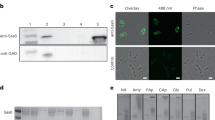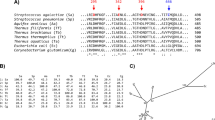Abstract
Since starch can be split into maltose, the opinion has been widespread that starch is composed of chains of the maltose type1. Some authors, however, suggested a branched or netted structure2,3; comparative measurements of molecular weight and viscosity were definitely in favour of a branched structure. Haworth4, on the other hand, deduced from end-group assays that the molecular weight is low and therefore starch is composed of straight chains of not more than twenty to thirty glucose units. However, such a view could not be maintained. Some years ago it became quite evident5 that most starches are made up of two polysaccharides: one unbranched, for which we proposed the old name of ‘amylose’, and one branched, ‘amylopectin’.
This is a preview of subscription content, access via your institution
Access options
Subscribe to this journal
Receive 51 print issues and online access
$199.00 per year
only $3.90 per issue
Buy this article
- Purchase on Springer Link
- Instant access to full article PDF
Prices may be subject to local taxes which are calculated during checkout
Similar content being viewed by others
References
Meyer, V., and Jacobson, P., "Lehrbuch der org. Chemie", 1, 2 Teil, 1624 ff. (1913).;
Meyer, K. H., Mark, H., "Aufbau der Hochpolymeren" (Leipzig, 1930).
Staudinger, H., and Husemann, E., Ann. Chemie, 195, 212 (1937).
Haworth, W. N., Nature, 129, 365 (1932). Hirst, E. L., Plant, M. M. T., and Wilkinson, M. D., J. Chem. Soc., 2375 (1932).
Meyer, K. H., Wertheim, M., and Bernfeld, P., Helv. Chim. Acta, 23, 865 (1940).
Haworth, W. N., Proc. Roy. Soc., A, 186, 1 (1946).
Meyer, K. H., and Bernfeld, P., Helv. Chim. Acta, 23, 875 (1940).
Meyer, K. H., and Gürtler, P., Helv. Chim. Acta, 30, 751 (1947).
Author information
Authors and Affiliations
Rights and permissions
About this article
Cite this article
MEYER, K., GÜRTLER, P. & BERNFELD, P. Structure of Amylopectin . Nature 160, 900–901 (1947). https://doi.org/10.1038/160900a0
Issue Date:
DOI: https://doi.org/10.1038/160900a0
Comments
By submitting a comment you agree to abide by our Terms and Community Guidelines. If you find something abusive or that does not comply with our terms or guidelines please flag it as inappropriate.



